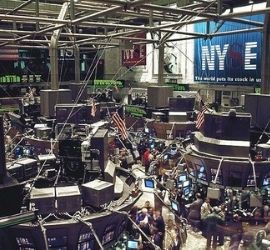What Is a Dow ETF vs Dow Jones ETF?
 An exchange-traded fund (ETF) is a type of security that involves a collection of securities, such as stocks. Often this collection of securities is designed to track an underlying index. However, they can be structured to track any number of industry sectors or use various strategies. A Dow ETF, or Dow Jones ETF is an exchange-traded fund that tracks the Dow Jones Industrial Average Index.
An exchange-traded fund (ETF) is a type of security that involves a collection of securities, such as stocks. Often this collection of securities is designed to track an underlying index. However, they can be structured to track any number of industry sectors or use various strategies. A Dow ETF, or Dow Jones ETF is an exchange-traded fund that tracks the Dow Jones Industrial Average Index.
ETFs in many ways are similar to mutual funds. However, they are listed on exchanges. As a result, ETF shares trade throughout the day just like an ordinary stock.
The Dow Jones ETF
The Dow Jones Industrial Average (DJIA) was created by Charles Dow in 1896. It is one of the oldest U.S. market indexes. It is commonly referred to as “the Dow” and stands alongside the S&P 500 and Nasdaq Composite. Together, these are the three main indexes tracking U.S. equities. But unlike those other two, the Dow is relatively small in size. The Dow is comprised of 30 blue-chip stocks and is price-weighted as opposed to cap-weighted. The Dow is commonly used by many investors as a quick appraisal for the health of the broader U.S. economy. However, the Dow’s total return over the past year is 7.7% compared to the S&P 500’s total return of 17.4%.
The Dow has recently faced intense volatility due to fears surrounding the coronavirus pandemic and other global geopolitical developments. Investors seeking to capitalize on the Dow without buying individual stocks may consider investing in an exchange-traded fund (ETF). These funds hold baskets of securities in order to provide efficiency and portfolio diversity as a means of reducing risk. The SPDR Dow Jones Industrial Average ETF (DIA) is currently the only non-leveraged ETF that tracks the Dow. As of August 10, 2020, the Dow has dramatically underperformed the S&P 500 with a total return of 7.7% compared to 17.4%, respectively.1 Below, we look at the one ETF that tracks the Dow. All figures below are as of August 11, 2020. (Sourceinvestopedia.com)
- Performance over 1-Year: 8.1%
- Expense Ratio: 0.16%
- Annual Dividend Yield: 2.18%
- 3-Month Average Daily Volume: 4,297,086
- Assets Under Management: $22.9 billion
- Inception Date: January 14, 1998
- Issuer: State Street SPDR
DIA is the ETF for investors seeking to replicate the performance of the Dow, which tracks the stocks of some of the largest companies in the U.S. economy. The fund may not be as diversified as most ETFs because it holds just 30 stocks, but these stocks belong to companies with strong fundamentals and finances. These factors give them greater capability than most companies to weather extremely adverse economic and market events. While these stocks are relatively safe, their fast-growth days are largely behind them, and many investors like them for reliable dividend payouts. DIA thus remains a popular choice for investors looking for relatively safe exposure to large-cap U.S. equities.3 Below, we’ll look at the top 10 holdings for DIA.
SPDR Dow Jones Industrial Average ETF holds all 30 stocks in the average and has tracked its performance accurately since the fund began in 1998. Like the index it tracks, the exchange-traded fund devotes 88% of assets to giant-size firms (those with more than $89 billion in assets), compared with 40% for the average large-company stock fund. Firms with the highest stock prices take the top spots in the portfolio, with Goldman Sachs (GS), 3M (MMM), and Boeing (BA) recently leading the way. The fund seeks to track the performance of the Dow, not beat it, but lately, that’s been good enough to beat broader better-diversified market barometers. In addition to beating the S&P 500, the fund’s 20.0% one-year return clobbered the performances of the Wilshire 5000 Total Market index (18.5%) and the Russell 1000 stock index (17.6%). (Source:Kiplinger.com)
Dow Jones ETF vs Dow Indexed Mutual Fund
ETFs and index funds both bundle together many individual investments into a single investment. In this case, we are looking at the Dow Jones Industrial Index. While ETFs and index funds have many of the same benefits, there are a few distinctions.
Mutual Fund vs Dow ETF
- Buying and Selling – The biggest difference between ETFs and index funds is that ETFs can be traded throughout the day like stocks, whereas index funds can be bought and sold only for the price set at the end of the trading day. For long-term investors, this issue isn’t of much concern. Buying or selling at noon or 4 p.m. will likely have little impact on the value of the investment in 20 years. However, if you’re interested in intraday trading, ETFs are a better way to go.
- Minimum Investment – In many cases, ETFs will have a lower minimum investment than index funds. Most of the time, all it takes to invest in an ETF is the amount needed to buy a single share, and some brokers even offer fractional shares. But for index mutual funds, brokers often put minimums in place that might be quite a bit higher than a typical share price. Vanguard, for example, has a minimum investment of $3,000 for most of its index funds, while T. Rowe Price has a minimum initial investment of $2,500.
- Tax Consideration – In general, ETFs are more tax-efficient than index funds. When you sell an ETF, you’re typically selling it to another investor who’s buying it. The cash is coming directly from them. As a result, capital gains taxes on that sale are yours and yours alone to pay. To get cash out of an index fund, you technically must redeem it from the fund manager. The manager, in turn, will then have to sell securities to generate the cash to pay to you. When this sale is for a profit, the net gains are passed on to every investor with shares in the fund. This means you could owe capital gains taxes without ever selling a single share.
Dogs of the Dow
Dogs of the Dow is a stock-picking strategy devoted to selecting the highest dividend-yielding Dow stocks. Investing in the Dogs of the Dow is relatively simple. The Dow Jones Industrial Average is made up of 30 stocks overall. After the stock market closes on the last day of each year, select the ten Dow stocks with the highest dividend yield. Then simply contact your broker and invest an equal dollar amount in each of these ten high yield stocks. Hold these ten Dogs of the Dow for one year. At the end of each year, repeat these steps
Dogs of the Dow ETF
Final Words
The DJIA is organized so that a $1 move in any company’s stock price will shift the Dow average by the same degree. However, Dow Jones is expensive to invest in outright, using futures for example. Investors seeking to mirror the performance of the Dow can invest in a number of ways. This includes using exchange-traded funds (ETFs) that track the Dow, to diversify their exposure.
The Dow Jones Industrial Average is comprised of blue-chip stocks. These tend to be considered low-risk. Nevertheless, you’re still investing, and investing inherently carries with it some degree of risk. It doesn’t matter whether you choose to invest in Dow Jones ETFs or alternative energy ETFs or ETFs in emerging markets. Ultimately, any investment, including ETFs should meet your financial needs without exceeding your risk tolerance.
Up Next: Gross Profit Margin – How to Calculate Gross Margin
Gross profit is the amount remaining after deducting the cost of goods sold (COGS) or direct costs from revenue. Gross profit margin is a measure of a company’s profitability. It is usually calculated as a percentage of revenue. The cost of goods sold is a measure of the direct costs required to produce a good or service, like materials and labor. However, it excludes indirect expenses like distribution costs, marketing, and accounting. This makes the gross profit margin most useful as a percentage of sales when tracking the direct cost of operations.
Other profit ratios, such as net profit margin, reflect different measures of profit. While the gross margin is a useful measurement of profitability. However, the net profit margin includes a company’s total expenses. As a result, it is even more specific. Net profit is closely scrutinized by analysts and investors.



